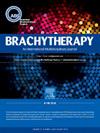GSOR11 Presentation Time: 5:50 PM
IF 1.7
4区 医学
Q4 ONCOLOGY
引用次数: 0
Abstract
Purpose
We sought to utilize the National Cancer Database (NCDB) to evaluate trends in radiation therapy (RT) boost modality and to assess outcomes between varying radiation modalities among medically inoperable endometrial cancer patients with locoregionally confined disease.
Materials and Methods
Patients with inoperable International Federation of Gynecology and Obstetrics (FIGO) stage I - IIIC2 endometrial cancer treated with radiation ± chemotherapy were analyzed. Practice patterns compared external beam radiation therapy (EBRT) versus high dose-rate (HDR) brachytherapy (BT) boost over time [2004 - 2019]. Kaplan-Meier method evaluated overall survival (OS) and Cox proportional hazard modeling assessed variables associated with OS.
Results
NCDB included 1,209 cases (EBRT: 780, BT: 429). EBRT boost patients were more often older (median age [y] EBRT: 70, BT: 68; p = 0.002), treated at a community or comprehensive community cancer program (p = 0.034), insured by the government (p = 0.018), and clinically node positive (p = 0.034). Phase I RT dose did not differ (median [cGy] EBRT: 4,500, BT: 4,500; p = 0.273), although phase II RT dose was lower among EBRT patients (median [cGy] EBRT: 1,440, BT: 2,080; p < 0.001). From 2004 to 2019, EBRT and BT boost rates differed (p = 0.001) with increasing rates of BT consolidation over time (cases in 2014 EBRT: 64 [76%], BT: 20 [24%]; cases in 2019 EBRT: 44 [46%], BT: 51 [54%]). Receipt of chemotherapy (odds ratio [OR] 1.64, 95% confidence interval [CI] 1.05 - 2.56; p = 0.028) was predictive of greater BT utilization while urban or metropolitan areas (rural vs urban OR 0.26, CI 0.092 - 0.74; p = 0.012; rural vs metropolitan OR 0.35, CI 0.14 - 0.92; p = 0.034) and nodal involvement (N0 vs N1 OR 0.47, CI 0.23 - 0.96; p = 0.039; N0 vs N2 OR 0.17, CI 0.035 - 0.84; p = 0.030) were associated with lower utilization of BT. Multivariable analysis (MVA) found BT was associated with lower mortality compared to EBRT (hazard ratio [HR] 0.80, CI 0.68 - 0.95; p = 0.011). MVA found these factors associated with inferior survival: increasing age (HR 1.03, CI 1.02 - 1.04; p < 0.001), greater T stage (T1 vs T2 HR 1.94, CI 1.13 - 3.33; p = 0.016; T1 vs T3 HR 1.66, CI 1.02 - 2.70; p = 0.040), greater N stage (N0 vs N1 HR 1.73, CI 1.20 - 2.49; p = 0.004), and moderately, poorly, or un-differentiated tumor grade (well differentiated [WD] vs moderately differentiated HR 1.28, CI 1.02 - 1.61; p = 0.034; WD vs poorly differentiated HR 1.75, CI 1.37 - 2.25; p < 0.001; WD vs undifferentiated HR 2.17, CI 1.32 - 3.57; p = 0.002).
Conclusions
The utilization of a brachytherapy boost for medically inoperable endometrial cancer has increased over time. Brachytherapy consolidation remains an effective RT modality for medically inoperable endometrial cancer, associated with lower mortality compared to EBRT consolidation.
GSOR11 演讲时间:下午 5:50
目的我们试图利用美国国家癌症数据库(NCDB)来评估放射治疗(RT)增强模式的趋势,并评估不同放射模式对局部区域局限的无法手术的子宫内膜癌患者的治疗效果。比较了2004-2019年间外照射放疗(EBRT)与高剂量率近距离放射治疗(BT)的实践模式。Kaplan-Meier法评估了总生存期(OS),Cox比例危险模型评估了与OS相关的变量。EBRT增效患者通常年龄较大(中位年龄[y] EBRT:70,BT:68;p = 0.002),在社区或综合性社区癌症项目接受治疗(p = 0.034),由政府投保(p = 0.018),临床结节阳性(p = 0.034)。第一阶段的 RT 剂量没有差异(中位数 [cGy] EBRT:4,500,BT:4,500;p = 0.273),但第二阶段的 RT 剂量在 EBRT 患者中较低(中位数 [cGy] EBRT:1,440,BT:2,080;p <0.001)。从2004年到2019年,EBRT和BT增强率存在差异(p = 0.001),随着时间的推移,BT巩固率越来越高(2014年EBRT病例:64 [76%],BT:20 [24%];2019年EBRT病例:44 [46%],BT:51 [54%])。接受化疗(几率比 [OR] 1.64,95% 置信区间 [CI] 1.05 - 2.56;P = 0.028)可预测更多的 BT 使用,而城市或大都市地区(农村 vs 城市 OR 0.26,CI 0.092 - 0.74;P = 0.012; rural vs metropolitan OR 0.35, CI 0.14 - 0.92; p = 0.034)和结节受累(N0 vs N1 OR 0.47, CI 0.23 - 0.96; p = 0.039; N0 vs N2 OR 0.17, CI 0.035 - 0.84; p = 0.030)与较低的 BT 使用率相关。多变量分析 (MVA) 发现,与 EBRT 相比,BT 与较低的死亡率相关(危险比 [HR] 0.80,CI 0.68 - 0.95;P = 0.011)。MVA 发现这些因素与较差的生存率相关:年龄增加(HR 1.03,CI 1.02 - 1.04;p < 0.001)、T 期增加(T1 vs T2 HR 1.94,CI 1.13 - 3.33;p = 0.016;T1 vs T3 HR 1.66,CI 1.02 - 2.70;p = 0.040)、N 期增加(N0 vs N1 HR 1.73,CI 1.20 - 2.49;p = 0.004),以及中度、低度或未分化肿瘤分级(分化良好 [WD] vs 中度分化 HR 1.28,CI 1.02 - 1.61;P = 0.034;WD vs 差分化 HR 1.75,CI 1.37 - 2.25; p < 0.001; WD vs 未分化 HR 2.17, CI 1.32 - 3.57; p = 0.002)。结论随着时间的推移,对医学上无法手术的子宫内膜癌使用近距离放射治疗的情况越来越多。近距离放疗巩固治疗仍然是治疗无法手术的子宫内膜癌的有效 RT 方式,与 EBRT 巩固治疗相比,其死亡率更低。
本文章由计算机程序翻译,如有差异,请以英文原文为准。
求助全文
约1分钟内获得全文
求助全文
来源期刊

Brachytherapy
医学-核医学
CiteScore
3.40
自引率
21.10%
发文量
119
审稿时长
9.1 weeks
期刊介绍:
Brachytherapy is an international and multidisciplinary journal that publishes original peer-reviewed articles and selected reviews on the techniques and clinical applications of interstitial and intracavitary radiation in the management of cancers. Laboratory and experimental research relevant to clinical practice is also included. Related disciplines include medical physics, medical oncology, and radiation oncology and radiology. Brachytherapy publishes technical advances, original articles, reviews, and point/counterpoint on controversial issues. Original articles that address any aspect of brachytherapy are invited. Letters to the Editor-in-Chief are encouraged.
 求助内容:
求助内容: 应助结果提醒方式:
应助结果提醒方式:


